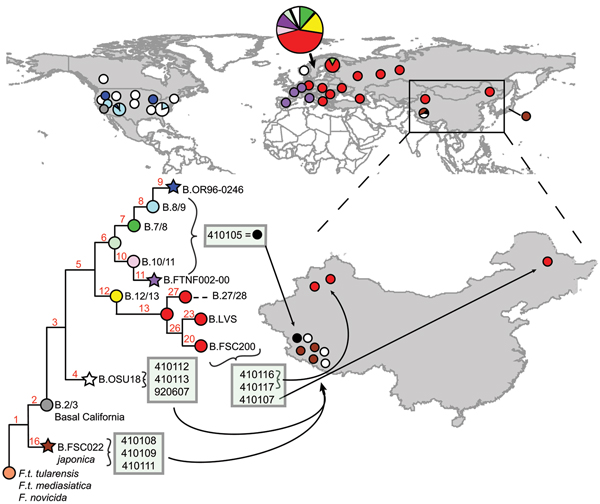Volume 20, Number 7—July 2014
Dispatch
Diversity of Francisella tularensis Subsp. holarctica Lineages, China
Figure 2

Figure 2. Phylogeography of Francisella tularensis (F.t.) subspholarctica. The global distribution of different clades (indicated by colored stars, circles, and circle sections) and their phylogenetic relationships (tree) are shown as described (6,7,11)Stars indicate sequenced reference strainsThe phylogenetic positions of the 10 isolates from China (boxes on tree) and their sites of isolation (circles within China) are indicatedThe exact lineage of strain 410105 (black circle) was not determined.
References
- Keim P, Johansson A, Wagner DM. Molecular epidemiology, evolution, and ecology of Francisella. Ann N Y Acad Sci. 2007;1105:30–66. DOIPubMedGoogle Scholar
- Petersen JM, Schriefer ME. Tularemia: emergence/re-emergence. Vet Res. 2005;36:455. DOIPubMedGoogle Scholar
- Keim PS, Wagner DM. Humans and evolutionary and ecological forces shaped the phylogeography of recently emerged diseases. Nat Rev Microbiol. 2009;7:813–21. DOIPubMedGoogle Scholar
- Jackson J, McGregor A, Cooley L, Ng J, Brown M, Ong CW, Francisella tularensis subspecies holarctica, Tasmania, Australia, 2011. Emerg Infect Dis. 2012;18:1484–6. DOIPubMedGoogle Scholar
- Johansson A, Farlow J, Larsson P, Dukerich M, Chambers E, Bystrom M, Worldwide genetic relationships among Francisella tularensis isolates determined by multiple-locus variable-number tandem repeat analysis. J Bacteriol. 2004;186:5808–18. DOIPubMedGoogle Scholar
- Svensson K, Granberg M, Karlsson L, Neubauerova V, Forsman M, Johansson A. A real-time PCR array for hierarchical identification of Francisella isolates. PLoS ONE. 2009;4:e8360. DOIPubMedGoogle Scholar
- Vogler AJ, Birdsell D, Price LB, Bowers JR, Beckstrom-Sternberg SM, Auerbach RK, Phylogeography of Francisella tularensis: global expansion of a highly fit clone. J Bacteriol. 2009;191:2474–84. DOIPubMedGoogle Scholar
- Olsufjev NG, Meshcheryakova IS. Subspecific taxonomy of Francisella tularensis McCoy and Chapin 1912. Int J Syst Bacteriol. 1983;33:872–4. DOIGoogle Scholar
- Kiliç S, Çelebi B, Acar B, Ataş M. In vitro susceptibility of isolates of Francisella tularensis from Turkey. Scand J Infect Dis. 2013;45:337–41. DOIPubMedGoogle Scholar
- Wang Y, Hai R, Zhang Z, Xia L, Cai H, Liang Y, Genetic relationship between Francisella tularensis strains from China and from other countries. Biomed Environ Sci. 2011;24:310–4.PubMedGoogle Scholar
- Gyuranecz M, Birdsell DN, Splettstoesser W, Seibold E, Beckstrom-Sternberg SM, Makrai L, Phylogeography of Francisella tularensis subsp. holarctica, Europe. Emerg Infect Dis. 2012;18:290–3. DOIPubMedGoogle Scholar
Page created: June 17, 2014
Page updated: June 17, 2014
Page reviewed: June 17, 2014
The conclusions, findings, and opinions expressed by authors contributing to this journal do not necessarily reflect the official position of the U.S. Department of Health and Human Services, the Public Health Service, the Centers for Disease Control and Prevention, or the authors' affiliated institutions. Use of trade names is for identification only and does not imply endorsement by any of the groups named above.